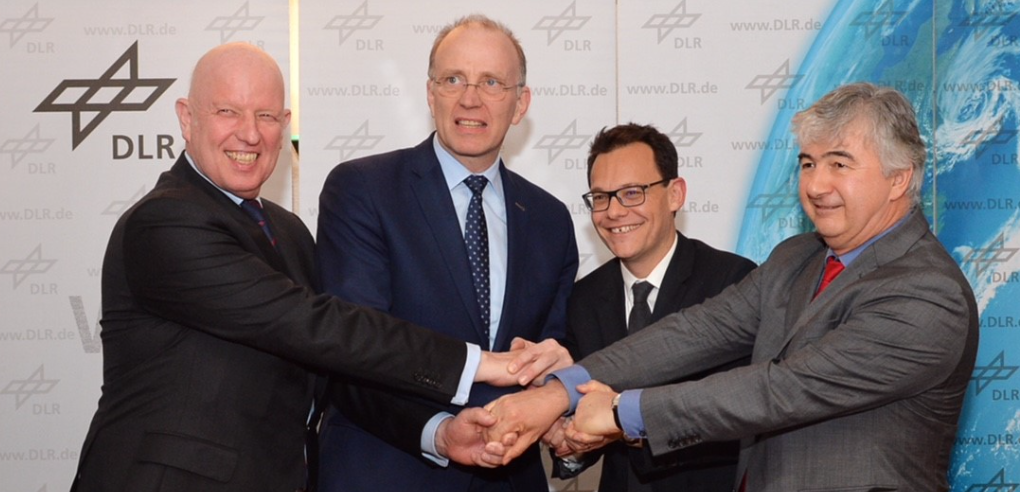
The launch may be a few years away but arrangements for such have to be done now, and that is what these two companies have agreed upon.
OHB System AG, a subsidiary of the Bremen-based space technology group OHB SE, has today signed a contract with the European launch services provider Arianespace for the launch of the Heinrich Hertz civil/military telecommunications satellite. In doing so, OHB has secured a flight opportunity on board an Ariane-5 launch vehicle.

Dr. Gerd Gruppe, Vorstand DLR-Raumfahrtmanagement; Marco R. Fuchs, OHB SE; Stephane Israel, Arianespace; Dr. Wolfgang Scheremet, BMWi

Heinrich Hertz will be transported to its geostationary orbit at around 36,000 km above the surface of the Earth on board an Ariane 5 in the fourth quarter of 2021. With a mass of 3.5 tons, the satellite will lift off from the European Kourou space center in French-Guyana. The launch contract was signed today with the Space Administration of the German Aerospace Center (DLR) in Bonn. Dr. Dieter Birreck, who is in charge of the Heinrich Hertz project at OHB said that they have in Arianespace a strong and reliable partner by their side.
OHB System AG was commissioned in summer 2017 by DLR Space Administration with the execution of this national satellite mission. “As the industrial prime contractor, we are responsible for implementing the entire mission including the satellite, the launcher and the related ground infrastructure. Our duties cover the development, assembly and verification of the telecommunications satellite as well as its launch and the preparation of in-orbit operations,” explains Dr. Birreck.

Artist’s impression of the Hertz satellite in space; © OHB System AG
Named for the German physicist Heinrich Hertz, it is Germany’s first national satellite communications mission since the DFS Kopernikus program involving a satellite engineered and built in Germany. Heinrich Hertz thus marks a further step in Germany’s return to full system capabilities in telecommunications satellites in accordance with the German space strategy adopted in 2010. The Heinrich Hertz mission pursues two goals:
- Civil: In-orbit verification of new technologies. For this purpose, roughly one dozen new technologies for satellite communications will be tested on board the satellite and a number of scientific/technical experiments performed.
- Military: Communications for the German federal armed forces. A dedicated payload will secure the continued operational capability of the German federal armed forces.
Marco Fuchs, Chief Executive Officer of OHB System AG, after signing the contract said that Heinrich Hertz comprises a number of different missions: For one thing, the DLR will be gaining a powerful platform for conducting important experiments in the field of satellite communications and, for another, the German Federal Ministry of Defense will have its own military segment of the payload providing satellite transmission capacities for the German federal armed forces on a long-term and future-proof basis.
With a planned duration of 15 years, the mission has been initiated by DLR for the German Federal Ministry for Economic Affairs and Energy in conjunction with the German Federal Ministry of Defense. Dr. Gerd Gruppe, a member of the DLR Space Administration board, who has been accompanying the project since its earliest days said that when it is launched in 2021 on board an Ariane 5, the Heinrich Hertz mission will lay the foundations for securing future satellite communications. With this mission, Germany is demonstrating its core capabilities in payload and platform technologies for geostationary satellites at an international level, thus reinforcing its system capabilities in these areas.

